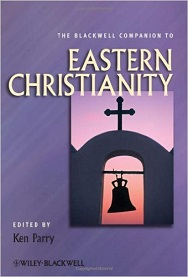 Will this book end up as shelf-furniture? I struggled with that question while writing this review. It’s a good book, but it may not be for you. The introduction correctly claims that the book has a lot of content: “Perhaps for the first time it is possible to trace within the cover of a single book the various strands that make up the rich tapestry of Eastern Christianity.” I liked the book, but I may not have made it all the way through if I didn’t have to write this review.
Will this book end up as shelf-furniture? I struggled with that question while writing this review. It’s a good book, but it may not be for you. The introduction correctly claims that the book has a lot of content: “Perhaps for the first time it is possible to trace within the cover of a single book the various strands that make up the rich tapestry of Eastern Christianity.” I liked the book, but I may not have made it all the way through if I didn’t have to write this review.
The book was written by 25 scholars, all of whom are qualified for what they were asked to write. There are 24 chapters: the first 15 cover different branches of Eastern Christianity. That includes the Eastern Catholic Church and Non-Chalcedonian churches, in addition to the Orthodox Church bodies. The first reason to recommend this book is that it closely examines the different members of the Eastern Church. This was a blessing for me. I will no longer lump the Eastern churches into the category of the Orthodox. This book also provides a survey of the blessings and care God has had for his church over the years. Even though the countries have been conquered by Muslims and Communists, the Word was still there.
This first section is a little uneven in its presentation. Some of the unevenness comes from the different authors who have different focuses. Because I’m a WELS pastor who believes that we are saved by faith, I want to hear what the churches believe. Because we test the spirits by what they teach, I want doctrine. Some of the authors did a good job of this. I came away with a much better understanding of the Non-Chalcedonian churches. For instance, one author explained why they prefer to be called Miaphysities and not Monophysites.
Some of the chapters, however, focus more on the polity and the history of the churches rather than on their doctrine. The chapter on the Bulgarian Orthodox Church, for example, lays out the struggle to be Autocephalous very well. It left me to assume that the only important difference between the Bulgarians and the other Orthodox is ethnicity. This may be true, because in writing about the church in America the author points out the struggle they have with church shoppers: “This is a challenge for the Church which, like most other Orthodox Churches, does not view the rest of the world as a potential field of missionary activity” (69). There isn’t anything poorly done in this section. It just comes from such a different perspective that it would be hard to use in ministry, if a pastor deals with one of these church bodies.
The second section of the book is a systematic approach to topics that are important to the Eastern Church. It has eight topical chapters that cover the Liturgical, Iconographic, and Hagiographic traditions of the Eastern Church. There is also one chapter on Sociology. These chapters are also well done. Just looking at the chapter titles, the differences between the Eastern Church and the Lutheran Church are very clear. There are no chapters on Justification or Sanctification. This section will help you to understand the spirituality of the Eastern Church.
The quotation that best encapsulated this section for me was about the conversion of Prince Vladimir (958-1015) to Christianity. His conversion came about from the report of the envoys about their experience with the liturgy: “We knew not whether we were in heaven, or earth; for on earth there is no such vision or beauty, and we know not how to describe it; we know only that there God dwells among men” (384). The Church was spreading, but the focus on beauty and emotional experiences seemed to leave out Christ crucified. To summarize the book, there is a lot of knowledge, tradition and beauty in the Eastern Church, but Christ is only there in passing.
Then should you buy and read it? Parts of it are very dense. It could easily become shelf furniture. But it can also be read as a book of 24 different essays, each one read separately. For that you have to know yourself. If you are dealing with a specific church body in your area, it probably won’t be very helpful. You would almost certainly get more mileage out of talking with the local priest or finding resources that are more specific to that portion of the Eastern Church. If you are looking for a broad overview of the Eastern Church to fill in some gaps in what you know, this would be a great book.
Ken Parry is a Senior Research Fellow and Lecturer in the Department of Ancient History, and member of the Ancient Cultures Research Centre. He studied philosophy, theology and comparative religion at the University of Manchester where he specialized in ancient and medieval philosophy, church history and patristics, and gained his doctorate in Byzantine theology. He researches and teaches in the areas of Late Antiquity, Byzantine Studies and Silk Road Studies, and is a convenor of the MA in Ancient Art and Architecture.

